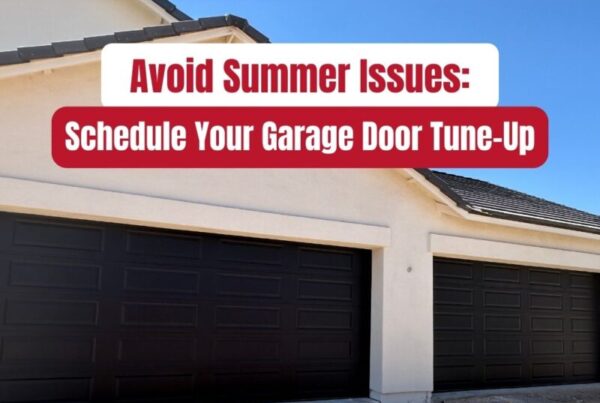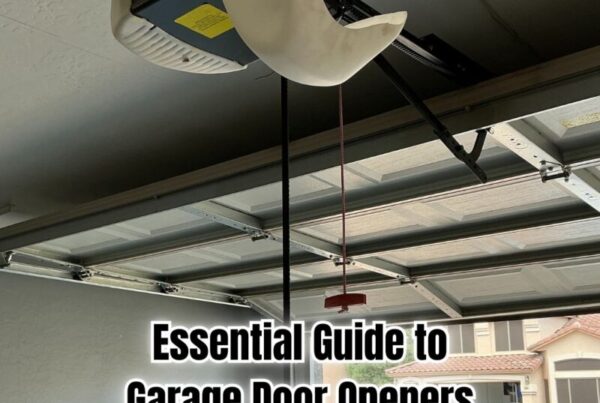
Garage Door Spring Replacement & Repair
Ever dealt with a jammed garage door that just refuses to work? I understand the frustration that comes with identifying broken or worn garage door springs and dealing with safety issues. In this post, I explain different garage door spring systems, offer insights on repair versus replacement, and share steps to replace springs professionally. This guide for garage door spring replacement & repair helps you solve your garage door problems easily and safely.
Identifying Broken or Worn Garage Door Springs

I often notice unusual sounds and uneven door movement pointing to spring concerns. I check for signs like worn wire and off-balance operation near the garage door opener, ensuring my springs garage door setup stays safe. This approach prevents mishaps during garage door installation and limits potential insurance issues.
Audible Signs of Spring Failure
I noticed a sharp, metallic clanging from the garage door mechanism, which signaled that the steel springs might be worn, and I knew it was time for some maintenance. I immediately tightened a loose screw on the metal framework and applied a lubricant to reduce friction and prevent additional damage.
Visual Clues Your Springs Need Attention
I observed that my garage door springs showed visible signs of damage, such as frayed coils and misalignment, indicating it was time to check thoroughly; sometimes, a loose wire on the spring meant that a quick fix with a wrench could delay more serious issues, which inspired me to email a local expert in Arizona for further insight and practical advice on handling similar garage door problems:
Garage Door Operation Issues Pointing to Spring Problems
I noticed my overhead door wasn’t opening and closing smoothly. The erratic movement suggested a problem with the spring mechanism—much like how a faulty ladder or unbalanced tool can affect performance. At one point, the door moved with the shaky motion of a wobbly window in a draft, and the faint sound of glass tapping the frame made me even more concerned. That moment pushed me to inspect the system more closely. From experience, I know that catching spring issues early helps avoid costly repairs later on.
Checking for an Off-Balance Garage Door
While checking for balance, I saw clear signs of wear on the torsion springs. I wanted to confirm whether rust had formed or if the warranty still covered replacement. Here’s what I did:
Inspected the spring alignment and checked for any gaps
Looked for rust and wear along the torsion mechanism
Considered getting advice from a hardware store like Home Depot
Recognizing Wear on Extension and Torsion Springs
When the diameter of the extension or torsion springs starts to change, it affects how the door moves. I’ve learned that a change in the coil shape is a clear warning. Replacing the springs early prevents bigger problems and keeps my garage door running smoothly. Staying ahead of these issues helps me stick to an efficient repair routine.
Understanding Different Garage Door Spring Systems

I check how the torsion springs, located at the center, and the extension springs along the sides work together to balance the weight of my garage door. Understanding their typical lifespan and the factors that affect their durability is part of my routine. When researching tips for replacing garage door springs, I turn to Google, always keeping safety in mind—especially with my car parked directly below.
Torsion Springs Location and Mechanism
I frequently check my torsion springs, which are located centrally above the garage door, making them crucial for balancing the door‘s energy during operation. When I perform garage door repairs, I rely on tools like locking pliers and a drill to ensure there is minimal risk of a spring break, keeping the mechanism secured and functioning reliably.
Extension Springs Location and Mechanism
I monitor my extension springs closely since they help balance the weight of my door and maintain proper tension; when I notice any unusual noise during operation, it often points me toward issues that might also affect the nearby torsion spring. I trust my handyman skills and experience, checking that the springs work smoothly and evenly to avoid misalignment or a drop in performance, which could lead to more costly repairs later.
How Springs Counterbalance Garage DoorWeight
I noticed that the springs work by evenly distributing the door‘s weight, where even minimal wear can affect overall balance and reduce life expectancy, making routine home improvement checks essential. When installing a new pulley system or replacing old springs—similar to replacing parts for my truck—I’ve learned that proper tension is vital to ensure smooth operation and avoid costly fixes later.
Typical Lifespan of Garage Door Springs
I learned that garage door springs typically last between eight and twelve years with proper maintenance, which includes checking the conetension, applying oil for smoother operation, and addressing nearby issues like plumbing and carpet damage that can impact overall performance in my phoenix setup:
- Regular lubrication with oil
- Monitoring conetension and alignment
- Inspecting surrounding areas for collateral damage
- Scheduling inspections if you live in areas like phoenix
Factors Influencing Spring Durability
I’ve learned that factors like proper torque settings, material quality, ongoing maintenance, and environmental exposure directly affect spring durability in my garage. When customers face rising cost concerns or decide to replace garage door springs, consider the following key elements:
- Material strength and design
- Accurate torque application during repair
- Regular inspection and lubrication
- Impact of local climate on wear
Safety Concerns With Broken Garage Springs

I know that high tension in garage springs can be risky, and my experience shows that DIY repairs might lead to injuries. I rely on professional help and check every set screw for secure operation, watch for heat build-up, and ensure safety cables are in place on extension springs to manage a compromised door safely.
High Tension Risks Associated With Garage Springs
I have found that garage springs under high tension can be risky, as a sudden break or shift may lead to accidents that affect both property and personal safety. I always take extra care by using proper tools and hiring expert help when dealing with these heavy-duty parts, and I have experienced firsthand the importance of regular checks in avoiding unexpected repair costs:
- Inspect the spring tension regularly
- Use safety cables on extension springs
- Seek professional assistance for repairs
Potential Injuries From Attempting DIY Spring Repairs
I learned that trying a DIY fix on garage springs can lead to sharp injuries and unexpected accidents because the tension involved is hefty and unforgiving, leaving little room for quick fixes:
Why Professional Help Is Advised for Spring Issues
I found that hiring an expert for garage door spring replacement and repair saves me time and stress. I learned from my own experience that professional guidance prevents accidents and ensures proper installation:
- Correct tension adjustment
- Safe removal of broken parts
- Accurate repair to meet safety standards
The Role of Safety Cables With Extension Springs
I notice that safety cables on extension springs play a crucial role in preventing accidents during garage door spring replacement and repair. I rely on these cables to secure any loose extension springs, keeping them from snapping dangerously during operation. My hands-on experience confirms that proper safety measures like this are essential for maintaining a safe environment while working on the door system.
Securely Managing a Garage Door With Damaged Springs
I learned that handling a garage door with damaged springs requires extra care to avoid any risk of sudden failure; I always ensure the door is securely locked and avoid frequent use until I can get professional advice:
Deciding Between Garage Door Spring Repair and Replacement

I assess whether a simple fix will suffice or if a full spring replacement is necessary. Clear signs often point to the need for complete replacement, and in many cases, I choose to replace both springs at the same time for balance and longevity. Weighing repair fees against replacement costs helps me make an informed decision, while also considering the long-term benefits of a fresh setup. Throughout the process, I prioritize safety and aim for smooth, reliable operation.
Assessing When Spring Repair Might Be Possible
I evaluated if a repair could work by carefully inspecting the wear and alignment of my garage door springs, noting that minor damage sometimes meant I could avoid a full replacement. In my experience, addressing small issues early with garage door spring repair can save time and money while keeping the door secure and functional.
Conditions Requiring Complete Spring Replacement
After routine inspections, I noticed that when my garage door springs display severe rust, significant coil deformation, and visible fraying marks, full replacement becomes essential to ensure safe operation:
- Severe rust compromising the spring’s strength
- Noticeable coil deformation indicating advanced wear
- Visible fraying or broken wires compromising stability
This firsthand experience has taught me that opting for complete replacement not only restores performance but also helps avoid potential hazards during regular garage door use.
Advantages of Replacing Both Springs Together
I learned that replacing both springs together offers better consistency in door balance and reduces the hassle of juggling different wear levels, ensuring my garage door operates smoothly every time I use it:
Comparing Costs Repair Versus Replacement
After weighing my options over the years, I found that the cost to fix minor issues on garage door springs is usually lower than a full replacement, but I often encountered recurring problems that warranted spending a bit more for new springs. I handle these decisions based on the severity of the wear and tear, practical insights from past repairs, and my desire to ensure my setup remains safe and reliable while keeping expenses in check.
Long-Term Benefits of New Springs Over Patching
I found that investing in new springs proves more effective over time, as they ensure a smoother operation and fewer unexpected issues, saving me from recurring repair hassles. This approach not only minimizes downtime but also improves overall safety and performance, making garage door spring replacement and repair a smarter long-term solution. I appreciate how reliable new springs are compared to temporary fixes that often lead to more complications.
Steps to Replace Garage Door Springs Professionally

I outline the key steps for garage door spring repair, starting with preparing the work area, performing safety checks, and carefully releasing built-up tension. From there, I walk through the process of removing old springs and correctly installing new ones. I also explain how to fine-tune the spring tension to ensure smooth and reliable operation during both repair and replacement projects.
Preparing the Work Area and Safety Precautions
I clear the workspace and secure the garage door to ensure it remains stable while I work on the springs. I make sure I have proper safety gear and reliable tools on hand, which helps me minimize risks and make the task more manageable. This careful preparation has always made my spring replacement projects go smoothly and safely.
Safely Releasing Existing Spring Tension
I carefully release the tension on my garage door springs by using secure locking pliers and following clear safety steps, which minimizes any risk of accidental release. I always double-check my setup before proceeding to remove the springs, ensuring a seamless transition to the replacement phase while keeping my workspace safe and controlled.
Method for Removing Old or Broken Garage Springs
I removed the old springs carefully by securing the door and slowly releasing the built-up tension with a suitable tool, ensuring I followed every safety precaution step-by-step; my approach included:
- Securing the garage door with locking pliers
- Gradually releasing the tension with a wrench
- Disconnecting the old spring assembly precisely
- Storing any broken parts safely
Correct Installation Procedures for New Springs
I always make sure to follow manufacturer instructions and measure tension accurately when installing new springs for my garage door, ensuring a smooth and secure operation. I carefully check each connection and use proper tools throughout the process, which has saved me time and prevented unexpected issues during my garage door repair projects. This hands-on experience has allowed me to confidently replace my springs and maintain a reliable and balanced door system.
Fine-Tuning Spring Tension for Smooth Operation
I always make sure to adjust the spring tension using the correct tools, which helps my door run smoothly and avoid any sudden jerks. My hands-on approach lets me quickly spot any slight misalignment, ensuring long-lasting, reliable operation that I can trust every time I use my garage door.
Choosing a Professional for Garage Door Spring Service

I rely on qualified garage door technicians to help me get accurate estimates for spring replacement. I always ask key questions about the repair process and review warranties on springs and workmanship before scheduling an appointment. These steps help me feel confident when arranging my garage door spring repair service.
Identifying Qualified Garage Door Technicians
I make sure to work with skilled professionals by checking their credentials and chat directly to understand their hands-on experience with spring replacement and repair tasks. I rely on indicators like certification, positive customer feedback, and regional expertise to feel confident in their ability to solve my garage door issues:
- Relevant certifications and credentials
- Positive feedback from previous projects
- Experience with spring repairs and replacements
- Local track record indicating timely service
Getting Accurate Estimates for Spring Replacement Costs
I made sure to ask for clear cost breakdowns and compare quotes from local experts to ensure I received fair pricing for spring replacement, while keeping my budget in check:
Key Questions for Service Providers Before Hiring
Before hiring a service provider for garage door spring replacement, I ask about their experience with spring repair. I also check the warranty they offer on parts and labor, and how they handle safety during installation. This direct approach helps me feel confident about the pricing and quality of service.
Reviewing Warranties Offered on Springs and Workmanship
I always confirm that the service includes a clear warranty on both the springs and the workmanship. A strong warranty can prevent future hassles and gives me peace of mind. It helps ensure the repair will last and that I’m protected from extra costs.
Arranging Your Garage Door Spring Repair Appointment
I scheduled my spring repair with a trusted local technician who understood my concerns. They provided a clear timeline and cost estimate, which made the process easy to follow. Their thorough explanation helped me feel confident. Getting this done made my garage door system safer and more reliable.




